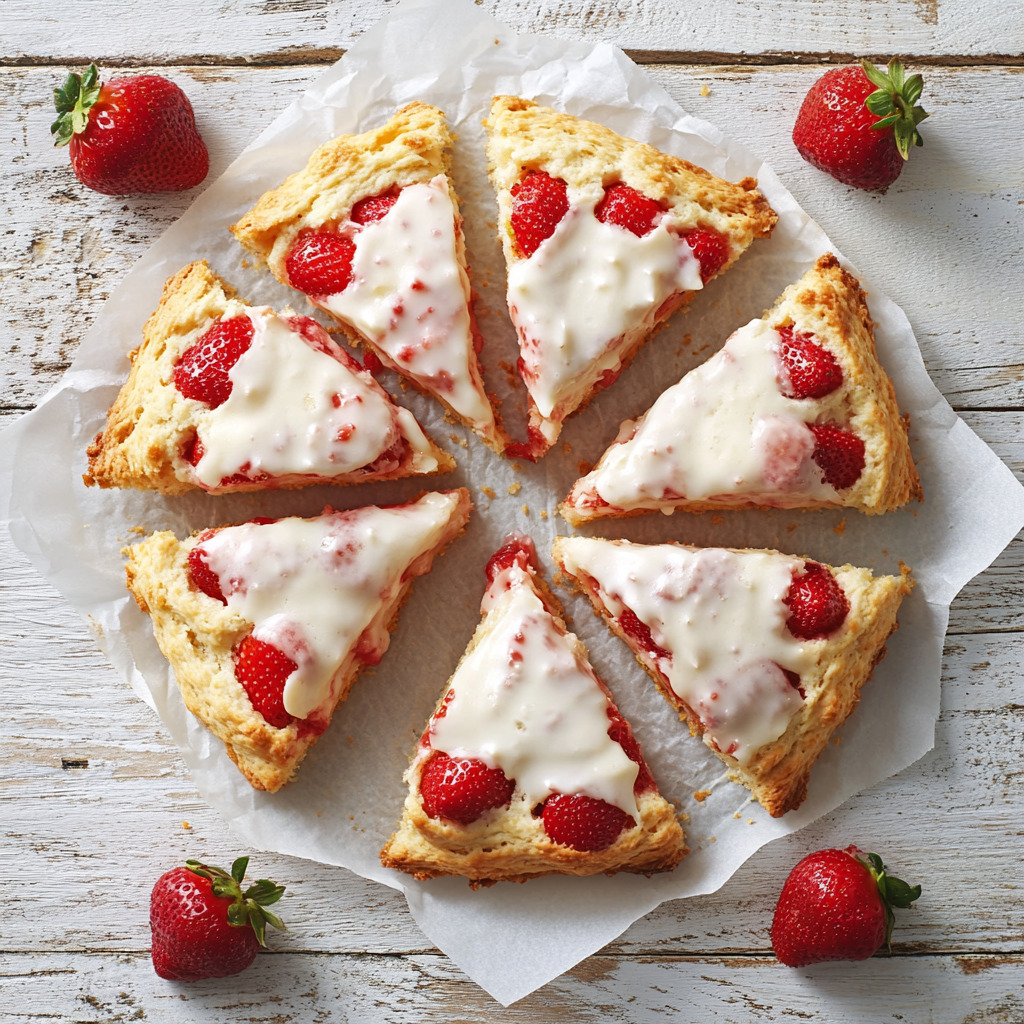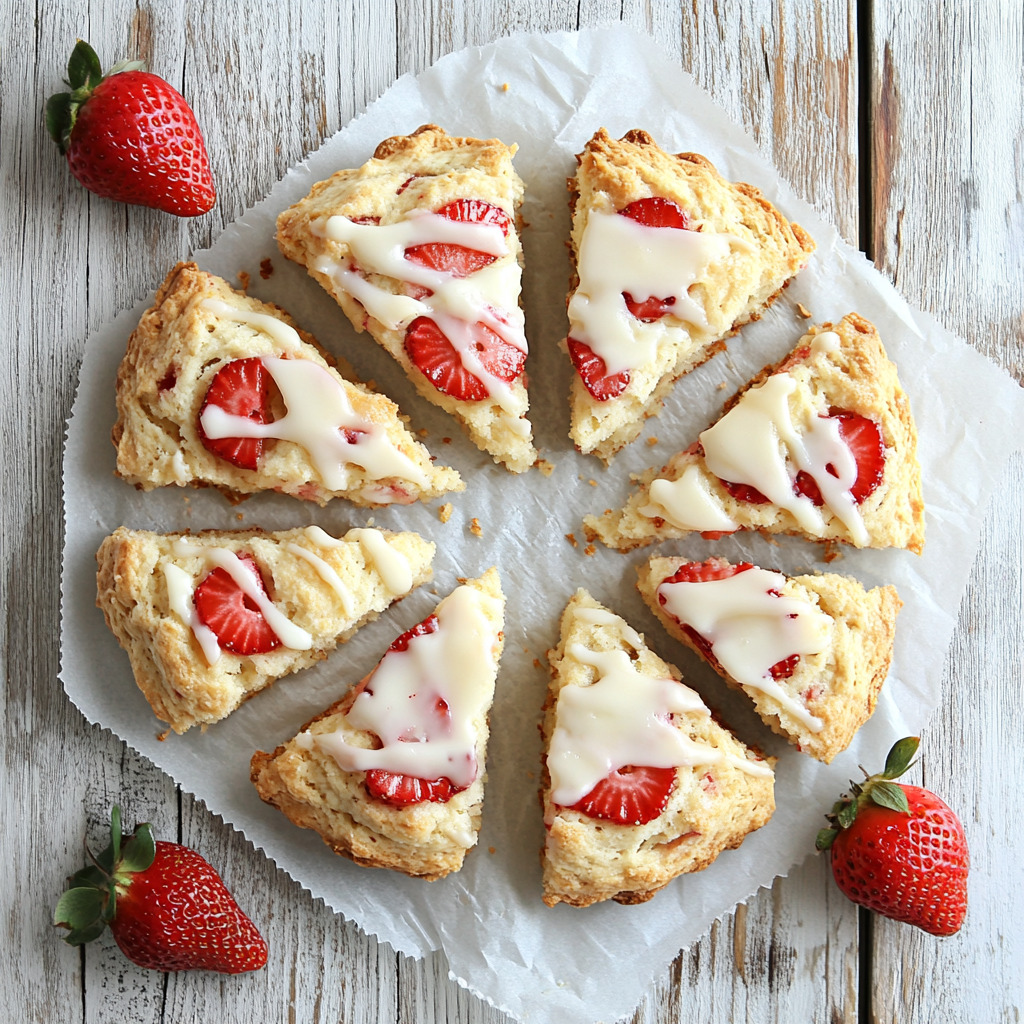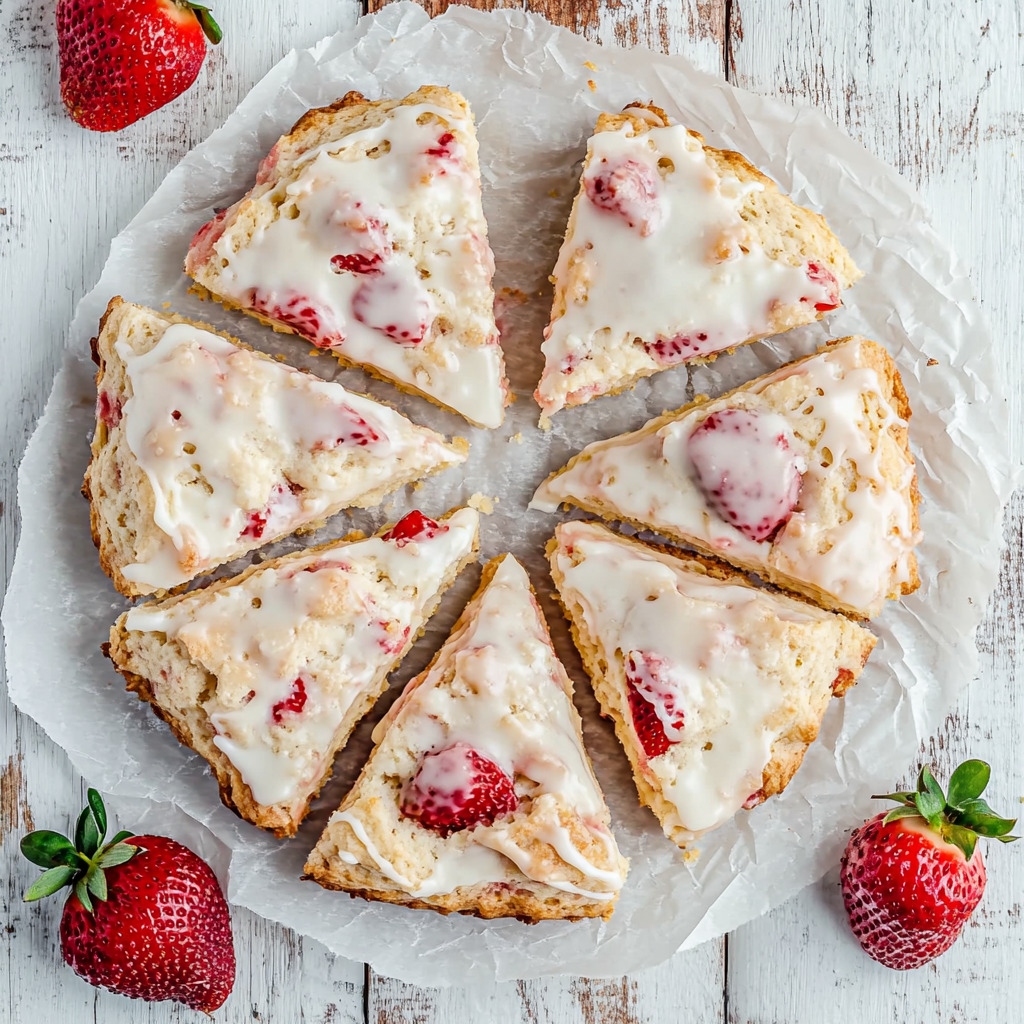Strawberry Scones
These Strawberry Scones are a celebration of seasonal simplicity—tender, buttery pastries infused with the delicate sweetness of fresh strawberries. Each bite offers a soft, flaky interior punctuated by juicy bursts of fruit, while a golden crust and vanilla glaze add texture and elegance.
Made with humble pantry staples and a handful of fresh ingredients, this recipe transforms basic baking into something truly special.
Whether served warm with tea or savored slowly with morning coffee, these scones capture the comfort of home and the brightness of spring in every bite.

Why People Will Love This Strawberry Scones Recipe:
Warm, homemade comfort: These scones deliver a nostalgic sense of coziness and warmth, perfect for slow mornings or thoughtful gatherings.
Fresh strawberries in every bite: The natural sweetness and subtle tartness of real fruit elevate the flavor far beyond typical store-bought pastries.
Buttery, flaky texture: The cold butter technique creates delicate layers that melt in your mouth, offering a satisfying contrast to the juicy berries.
Not overly sweet: Balanced sweetness allows the strawberries and buttery crumb to shine—perfect for those who prefer less sugary treats.
Finished with a delicate glaze: The simple vanilla glaze adds a polished finish, both visually and in flavor, without overwhelming the pastry.
Versatile and seasonal: Ideal for brunches, picnics, or holiday mornings, and easily adapted with other fruits or flavor add-ins like lemon zest or white chocolate.
Impressive yet easy: Though they look and taste bakery-quality, these scones require no special equipment—just thoughtful handling and fresh ingredients.
Key Ingredients:
All-Purpose Flour: The structural backbone of the scones—providing the delicate crumb that supports the tender texture while remaining light and flaky.
Cold Unsalted Butter: Essential for flakiness and richness. As it melts during baking, it releases steam, creating airy layers and a deeply satisfying mouthfeel.
Fresh Strawberries: The vibrant heart of the recipe—juicy, slightly tart, and naturally sweet—these berries bring bursts of flavor and seasonal brightness to each bite.
Whole Milk: Adds moisture and richness, gently binding the dough and softening the overall texture without weighing it down.
Granulated Sugar: A subtle sweetener that enhances the natural flavor of the strawberries and contributes to the golden color during baking.
Baking Powder: The leavening force that ensures a tender rise, creating lightness without the need for yeast or long resting times.
Coarse Sugar: Sprinkled on top for visual appeal and a satisfying crunch—adding contrast to the tender interior and elevating each bite.
Powdered Sugar & Vanilla Extract (in the glaze): A silky, aromatic drizzle that adds a final layer of sweetness and depth, balancing the tartness of the berries and completing the scone with elegance.

Expert Tips:
Use very cold butter—and work fast: Cold butter is crucial for creating flakiness. Keep it in the fridge until just before use, and if your kitchen is warm, freeze the butter cubes for 10 minutes. Handle the dough quickly to prevent melting.
Grate or flatten the butter: For even flakier layers, use a box grater to shred the butter into the flour, or flatten the cubes slightly with your fingers during mixing. This increases surface area and steam pockets when baking.
Pat strawberries dry: Fresh strawberries contain a lot of moisture. After dicing, blot them gently with a paper towel to prevent the dough from becoming soggy or overly wet.
Chill the dough before baking: After shaping and cutting the scones, refrigerate them for 15–30 minutes. This re-solidifies the butter, which helps maintain shape and maximizes flakiness in the oven.
Flour your hands lightly when shaping: Scone dough is sticky by nature. Lightly flouring your hands (not the dough) prevents sticking while preserving the soft, moist texture of the scones.
Separate wedges slightly before baking: Giving the scones a little room to expand encourages even browning and helps them rise better rather than baking into each other.
Don’t overmix: Stir the dough only until it just comes together. Overworking activates gluten, leading to tough, dense scones instead of tender, crumbly ones.
Adjust baking time for your oven: Ovens vary—check for doneness at 25 minutes. Scones should be deeply golden on the edges and firm to the touch on top.

Strawberry Scones
Ingredients
For the scone dough:
1 cup whole milk, cold (8oz)
¼ cup granulated sugar (55g)
½ teaspoon salt
3 cups all-purpose flour (378g)
2 ½ teaspoons baking powder
10 tablespoons unsalted butter, cold (5oz)
1 cup diced strawberries, plus two extra strawberries for topping
1 tablespoon coarse sugar, for topping
For the glaze:
1 cup powdered sugar (115g)
¼ teaspoon vanilla extract
1 tablespoon milk, cream or water
Instructions
To Make the Scones:
Preheat your oven to 375°F (190°C). Line a baking sheet with parchment paper and set it aside.
In a large measuring cup, whisk together the cold milk, granulated sugar, and salt until fully dissolved. Set aside.
In a large mixing bowl, whisk the flour and baking powder to combine. Add the cold butter, cut into ½-inch cubes. Use a pastry cutter (or your fingers) to blend the butter into the flour until only pea-sized pieces remain.
Gently fold in the diced strawberries, being careful not to crush them.
Pour the milk mixture into the flour mixture and stir with a wooden spoon or firm spatula until the dough just comes together. Do not overmix.
Line an 8-inch cake pan with a double layer of plastic wrap, letting the excess hang over the edges. With lightly floured hands, press the dough into the pan evenly to form a smooth, round shape. Lightly flour the top if sticky.
Lift the dough out using the plastic wrap and place it onto the prepared baking sheet. Remove the wrap.
Chop the extra strawberries into ½-inch pieces and gently press them into the top of the dough for decoration.
Brush the top with milk and generously sprinkle with coarse sugar.
Slice the round into 8 wedges, slightly separating each one to allow for even baking.
Bake for 25–30 minutes, or until the scones are golden brown. Let them cool on a wire rack before glazing.
To Make the Glaze:
In a small bowl, whisk the powdered sugar, vanilla extract, and milk (or water/cream) until smooth.
Drizzle over warm or cooled scones. Serve and enjoy!
Important Notes When Making Strawberry Scones
Moisture management is key: Strawberries release water as they bake, which can weigh down the dough or cause soggy pockets. Use firm, ripe berries (not overripe), dice them small, and gently blot them dry before folding into the dough.
Cold ingredients = flaky texture: The temperature of your butter, milk, and even flour affects the final texture. Keeping everything cold prevents premature melting, helping the scones rise with light layers and golden edges.
Don’t skip the chilling step: If the dough feels warm or sticky after shaping, chill it before baking. This step helps the butter firm up again, reducing spread and promoting defined, tall scones.
Minimal handling yields tenderness: Scone dough should be treated gently. Over-mixing or kneading develops too much gluten, which leads to a tough, bread-like texture. Stop mixing as soon as the dough comes together.
Bake scones spaced apart: After cutting into wedges, give each piece room to expand. This ensures crisp edges and even cooking—otherwise, they’ll steam and bake together instead of browning individually.
Scones are best fresh, but freeze beautifully: These are at their flakiest and most aromatic the day they’re baked, but they can be frozen unbaked or baked. If freezing unbaked, cut and freeze the dough wedges, then bake straight from frozen, adding a few minutes to the bake time.
Watch the glaze consistency: The glaze should be pourable but not runny. Add liquid a teaspoon at a time to avoid thinning it too much, and wait until the scones are slightly cooled before drizzling to prevent it from melting.
Nutrition Information
(Per Scone – with glaze, approx. 1 serving)
Calories: 330 | Total Fat: 15g | Saturated Fat: 9g | Trans Fat: 0g | Cholesterol: 40mg | Sodium: 230mg | Total Carbohydrates: 45g | Dietary Fiber: 1g | Sugars: 18g | Protein: 5g | Calcium: ~90mg (7% DV) | Iron: ~1.8mg (10% DV) | Potassium: ~150mg
Notes:
Using cream instead of milk in the glaze or adding extra coarse sugar topping will slightly increase calories and fat.
Reducing the glaze or sugar topping can lower total sugar per serving by ~3–5g.
Strawberries add natural sweetness and vitamin C but contribute minimal calories.
Frequently Asked Questions:
Can I use frozen strawberries instead of fresh?
Yes—but thaw them completely and drain well, then pat dry with paper towels before adding to the dough.
Frozen berries release more water and can make the scones soggy if not handled carefully.
Why is my dough too sticky to handle?
Strawberries add moisture to the dough, especially if overripe.
If your dough becomes too sticky, lightly flour your hands and work surface, but avoid adding too much extra flour, which can make the scones tough.
Can I make the dough ahead of time?
Yes—shape the dough into a round, cut it into wedges, and refrigerate overnight or freeze.
If baking from frozen, add 2–3 extra minutes to the bake time.
How do I know when the scones are done baking?
Look for a deep golden color on the edges and tops.
The scones should feel firm and set in the center.
If they look pale or feel soft, give them a few more minutes.
Can I skip the glaze or use something else?
Absolutely! The glaze adds sweetness and shine, but you can skip it for a less sweet, more rustic scone. Alternatively, brush with warm jam, dust with powdered sugar, or serve with clotted cream or whipped butter.
Should the butter be grated, cubed, or melted for the dough?
The butter should be cold and cubed—never melted. Keeping it solid allows it to create steam pockets during baking, which leads to flaky, tender layers in the scones.
What’s the best way to incorporate the strawberries without smashing them?
After patting the diced strawberries dry, gently fold them in at the very end using a soft spatula or your hands. Avoid stirring too vigorously, which can release excess moisture and stain the dough.
How do I avoid overmixing the dough?
Mix the wet and dry ingredients just until combined. Stop as soon as no dry streaks remain. Overmixing develops gluten, which leads to dense, chewy scones rather than soft, crumbly ones.
Why do I need to chill the dough before baking?
Chilling the dough firms up the butter again and allows the flour to hydrate slightly, which helps the scones hold their shape and rise higher during baking.
Can I use a different pan instead of shaping in a cake pan?
Yes! The cake pan method helps create an even round shape, but you can simply pat the dough into a circle by hand on a floured surface, then cut it into wedges and bake directly on a parchment-lined sheet.